Curated OER
John Muir Nature Journal
Students explain how John Muir carefully and quietly observed nature and record his observations in his journal with writings and drawings. Students create their own nature observation journal.
Curated OER
Human Heart Anatomy
Young scholars identify the 4-chambers and major blood vessels of the heart and
construct a model of a 4-chamber heart. They sketch their model, identify the chambers/vessels, state the condition of the blood in each chamber/vessel,...
Curated OER
Underneath the Microscope
Eighth graders enhance their skills in operating a microscope. They become comfortable with the vocabulary associated with microscopes and investigate how to place slides and focus them properly using the microscope. Students are given...
Curated OER
Arthropod Data Collection
Students describe the life cycle of various bugs as well as their predators and feeding habits. The class participates in a discussion of the various methods scientists use to gather data including research and experiment. After...
Curated OER
Understanding Cells
Students identify and define several related vocabulary terms. Students complete a short lab and complete the questions. Students create a cell crossword puzzle and play cell computer games through the included links.
Curated OER
Cell 4 Organelles Review
Students list and define all of the major organelles in a eukaryotic cell. They identify the correct placement of all the major organelles in a eukaryotic cell. They examine cell membrane and its function.
Curated OER
Natural Selection
Eighth graders define natural selection and adaptation. They simulate natural selection within a species and relate the elements of natural selection to the simulation. They analyze the results of natural selection in terms of...
Curated OER
Elements and the Periodic Table
Young scholars are introduced to the elements on the Periodic Table and what is meant by element. Using the Table, they identify the name, atomic mass, number and symbol of each element. To end the lesson, they discover the...
Curated OER
Food Webs
Learners investigate the concept of an ecosystem and how they are interconnected according to a hierarchy. Students are exposed to the "Lion King" as an example of a food chain and this is very relevant. They answer several key...
Curated OER
Methods of Heat Transfer
Eighth graders are introduced to the various types of heat transfer methods. After taking a quiz, they pretend their hands are cold and offer suggestions on how to warm them up. They explain each type of heat transfer method and give...
Curated OER
Osmosis
Learners explore diffusion and active transport. They observe the effects of eggs in vinegar and predict what will happen when eggs are placed in corn syrup with food coloring. Students complete worksheets which lead them to describe...
Curated OER
Incomplete dominance, Codominance, Multiple Alleles
Students explore the principles of incomplete dominance and codominance in genes. They apply genetic previously discussed genetic principles to determine solutions to inheritance problems including multiple alleles, incomplete dominance...
Curated OER
Newton's Laws
Eighth graders distinguish between and apply Newton's Laws. They take a quiz reviewing Kinetic and Potential Energy. Students explain that they have just demonstrated Newton's three laws of motion. They also explain what forces are...
Curated OER
Sexual Versus Asexual Reproduction
Students discuss the prefix "a" as in atypical and abiotic. They coy definitions of sexual and asexual reproduction into their notes. Students use prior knowledge of mitosis, meiosis, and previous diagrams to describe what happens in...
Curated OER
Non-Fiction Animal Picture Books
Students complete a multi-lesson plan unit using research to create their own book about an animal of their choice. After discussing the elements of non-fiction texts, they use internet research to explore an animal of interest to them....
Curated OER
Review of the Scientific Method
Learners review the Scientific Method with a hands-on activity. Working with a partner, they hypothesize the number of water drops that fit on the heads side of a penny. They collect data and share their results with the remainder of...
Curated OER
Upwelling Terrestrial Radiation
Students calculate the hourly irradiance of the earth at a site given the near-surface air temperature of the site. They compare the calculated values of irradiance with those measured by instruments at the site. Students need to...
Curated OER
Matter and Change
In this matter and change activity, learners answer 24 questions on topics such as elements, compounds, mixtures and chemical reactions. Students answer questions about the properties of matter such as their physical state and shape. In...
Curated OER
The Three States of Matter
Third graders identify properties of solids, liquids, and gasses. In this states of matter lesson, the teacher demonstrates the properties of each state of matter, then students go on a scavenger hunt for items to represent each state...
Curated OER
Oobleck/Slime War
Students compare slime recipes. In this properties of matter lesson, students make Oobleck and glurch and compare the properties of each and examine the solid and liquid properties of them.
Curated OER
Build a Bubble-Powered Rocket
In this law of action and reaction worksheet, students build a bubble powered rocket using a film canister, paper and effervescing tablets to create bubbles inside the canister of the rocket. The pressure inside causes the canister to...
Curated OER
Recipe For Recycling
In this recycling activity worksheet, students follow a given "recipe" to make recycled paper using a blender, then create a picture, card or collage with the material.
Curated OER
All Wrapped Up
Students explore packaging. In this cross-curriculum lesson, students bring in samples of food packaging and identify the packaging as natural or manufactured.
Curated OER
Recycle and Respect!
Students explore how they can be a philanthropist. In this recycling instructional activity, students learn what it means to recycle and discuss why items need to be recycled. Students review the term philanthropy and practice this by...

























